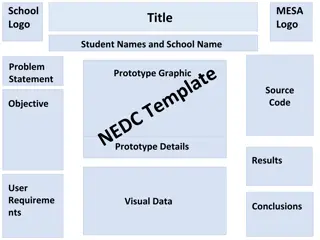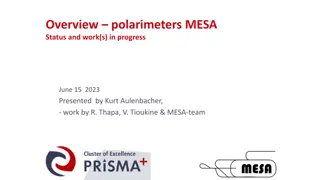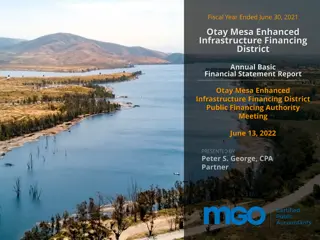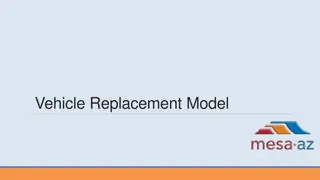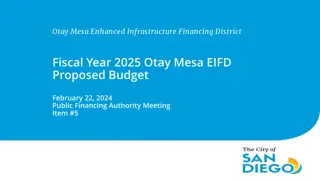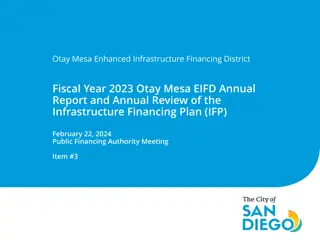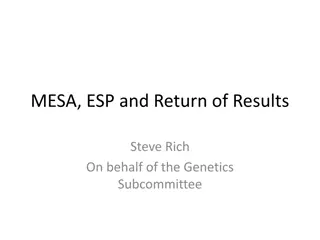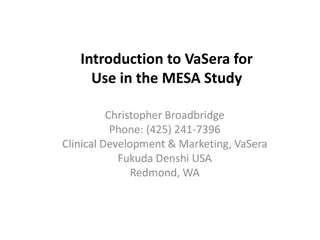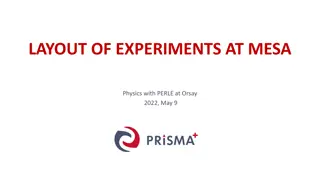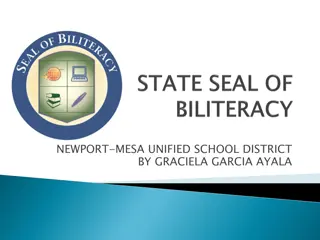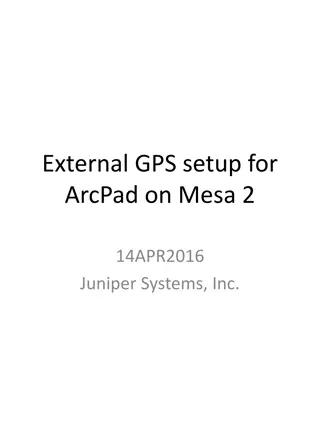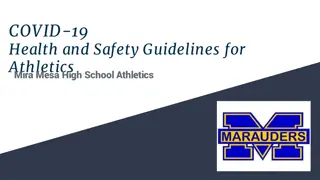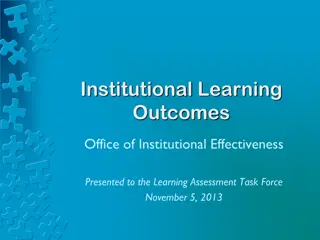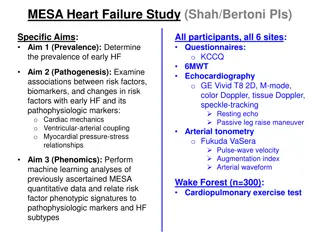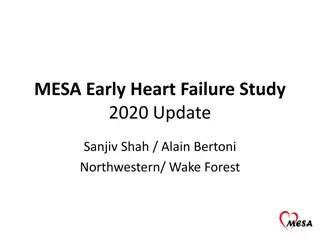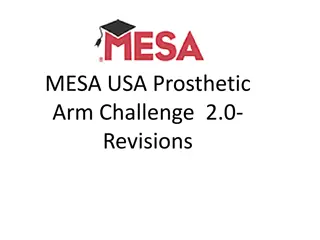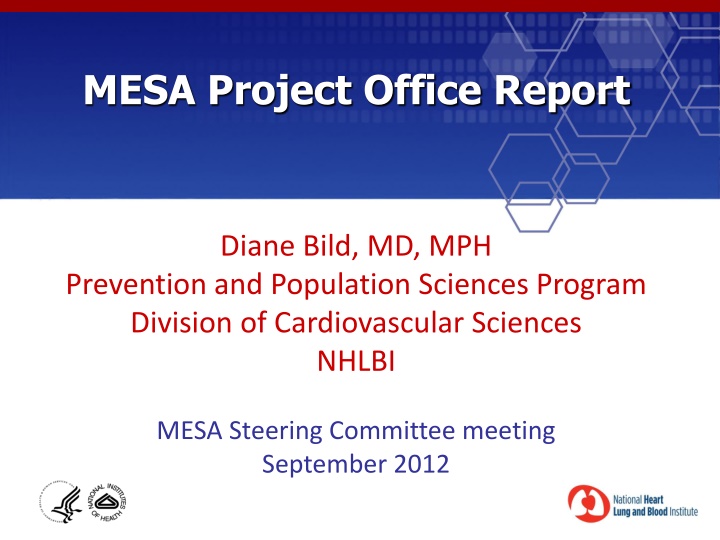
NHLBI MESA Project Office Report Summary September 2012
Dive into the latest developments of the NHLBI MESA Project Office Report from September 2012, covering publications, metrics, NIH and NHLBI news, OSMB recommendations, and more. Discover insights on high-impact journal papers, director transitions, budget cuts, and strategic retention strategies for the study.
Download Presentation

Please find below an Image/Link to download the presentation.
The content on the website is provided AS IS for your information and personal use only. It may not be sold, licensed, or shared on other websites without obtaining consent from the author. If you encounter any issues during the download, it is possible that the publisher has removed the file from their server.
You are allowed to download the files provided on this website for personal or commercial use, subject to the condition that they are used lawfully. All files are the property of their respective owners.
The content on the website is provided AS IS for your information and personal use only. It may not be sold, licensed, or shared on other websites without obtaining consent from the author.
E N D
Presentation Transcript
MESA Project Office Report Diane Bild, MD, MPH Prevention and Population Sciences Program Division of Cardiovascular Sciences NHLBI MESA Steering Committee meeting September 2012
Project Office Report Items Publications NIH and NHLBI news Next steps for MESA OSMB meeting
MESA Publications 120 104 100 Number of Manuscripts (n=486) 80 75 75 80 69 60 40 34 31 20 13 3 1 1 0 20022003200420052006200720082009201020112012 Published or in press as of August 28, 2012.
Other metrics Papers in high-impact journals (IF > 10) since the last meeting: Nature (36.3) 1 (genetics BP consortium) JAMA (30.0) 2 (subclinical, diabetes & mortality) Circulation (14.4) 1 JACC (14.3) 2 New Engl J Med (53.5) 1 (in press) 29 out of 34 abstracts submitted to AHA Scientific Sessions were accepted.
NIH and NHLBI news Gary Gibbons became NHLBI Director on August 13, 2012. Sequestration would result in $2.4B cut to NIH, and 700 fewer grants in FY13. For NHLBI, this would be a $240M cut from a budget of $3.08B. DCVS is planning a robust set of workshops for FY13 stay tuned. Epidemiology digital forum still active - http://www.nhlbi.nih.gov/resources/epidemiology -forum/ Report from Sen. Tom Harkin, Chairman, Sen. Appropriations Subcommittee on Labor, Health and Human Services, July 25, 2012
OSMB recommendations Would like a scientific presentation on statistical methods Add a pulmonary expert to the OSMB Provide metrics on number of publications and collaborations and how collaborations are encouraged; compare to other studies How is consent obtained from cognitively impaired individuals? Describe age distribution by ethnicity strategies will be needed for retention
OSMB recommendations Retention by center is uneven a strategy should be put in place for centers that are not retaining as well Look at reasons why exams were not completed in Exam 5 Non-coronary pathology/unexpected findings from CT and MRI
Recommendations about renewal What are the main findings of MESA? What are the implications for prevention? Issues in the elderly, frailty, particularly with multiethnicity What are the gaps among the cohort studies? Ask the investigators what questions could be answered Consider informative subgroups Consider an offspring study MRI plaque; MRI inflammation Peripheral vascular disease; MRI assessment Cognition, brain issues Ask the investigators what they think should be studied
MESA continuation mechanisms Contracts are for government needs or projects that require strong central coordination and control E.g., used to fill looming gaps in data in key age or ethnic groups Contracts tend to be competitive. Grants tend to be more nimble in proposing new science, high risk projects, or cutting edge ideas E.g., used to augment contracts with investigators ideas
Options 1. Support event surveillance and data analysis only PRO - Maximizes ability to utilize all prior data - Larger number of events provides power to investigate subgroups - Less expensive than supporting an exam - Success with similar models - Creates some opportunity to support productive investigative team CON - Not innovative
Options 2. Support core Exam 6 with basic measurements PRO - Allows basic investigation of trends in risk factors - Creates the opportunity for ancillary studies requiring new data collection CON - Retention in the oldest age groups likely to be poor; might need to do home visits, which limits exam procedures in this group - Costs higher than surveillance only
Options 3. Support complete Exam 6 PRO - Possible innovative measurements can be made - Allows basic investigation of trends in risk factors - Creates the opportunity for ancillary studies CON - It is not clear what innovative exam components to include - Retention in the oldest age groups likely to be poor; might need to do home visits, which limits exam procedures - Costs very high
Options 4. Provide no active support PRO -Saves funds for other projects CON - Missed opportunity to maximize use of data and samples by linking to more events - Unlikely that grants can coordinate efficiently to collect new exam data - Loss of investigative group
MESA continuation - steps for contract renewals and RFAs Project Office develops concept Idea Forum discussion within NHLBI NHLBI Board of External Experts review NHLB Advisory Council review of concept NHLBI Director approval Contracts: ~6 months to release of RFPs ~13 months to awards Grants: ~7 months to publication in the NIH Guide ~13 months to awards

